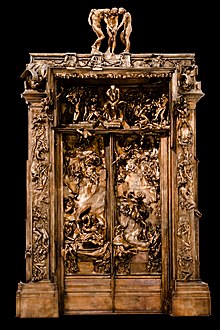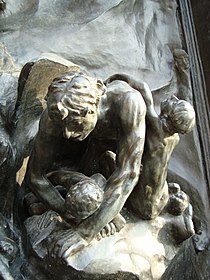| The Gates of Hell | |
|---|---|
 at the Museo Soumaya | |
| Artist | Auguste Rodin |
| Medium | Bronze |
| Location | Musée D’Orsay, Paris (plaster model); casts in various places |
The Gates of Hell (French: La Porte de l'Enfer) is a monumental bronze sculptural group work by French artist Auguste Rodin that depicts a scene from the Inferno, the first section of Dante Alighieri's Divine Comedy. It stands at 6 metres high, 4 metres wide and 1 metre deep (19.7×13.1×3.3 ft) and contains 180 figures.
Several casts of the work were made, which are now in various locations around the world. Rodin's original plaster model is in the Musée D’Orsay, Paris. The figures range from 15 centimetres (6 in) high up to more than one metre (3 ft). Several of the figures were also cast as independent free-standing statues.
The sculpture was commissioned by the Directorate of Fine Arts in 1880 and was meant to be delivered in 1885.[citation needed] Rodin would continue to work on and off on this project for 37 years, until his death in 1917.[citation needed]
The Directorate asked for an inviting entrance to a planned Decorative Arts Museum with the theme being left to Rodin's selection. Even before this commission, Rodin had developed sketches of some of Dante's characters based on his admiration of Dante's Inferno.[1]
The Decorative Arts Museum was never built. Rodin worked on this project on the ground floor of the Hôtel Biron. Near the end of his life, Rodin donated sculptures, drawings and reproduction rights to the French government. In 1919, two years after his death, the Hôtel Biron became the Musée Rodin, housing a cast of The Gates of Hell and related works.[citation needed]
Through me the way into the suffering city,
Through me the way to the eternal pain,
Through me the way that runs among the lost.
Justice urged on my high artificer;
My Maker was Divine authority,
The highest Wisdom, and the primal Love.
Before me nothing but eternal things
Were made, and I endure eternally.
Abandon every hope, who enter here.
Rodin conceived that people would walk toward the work, perhaps up a flight of stairs, and be overwhelmed frontally by the massive gates, contemplating the experience of hell that Dante describes in his Inferno. Rodin thought particularly of Dante's warning over the entrance of the Inferno, "Abandon every hope, who enter here."[2]
A work of the scope of The Gates of Hell had not been attempted before, but inspiration came from Lorenzo Ghiberti's Gates of Paradise at the Baptistery of St. John, Florence, 15th century bronze doors depicting figures from the Old Testament. Another source of inspiration was medieval cathedrals combining high and low relief. Rodin was also inspired by Michelangelo's fresco The Last Judgment, Delacroix's painting The Barque of Dante, Balzac's collection La Comédie humaine and Baudelaire's poems Les Fleurs du mal.[3][4]
In an article in Le Matin, Rodin said: "For a whole year I lived with Dante, with him alone, drawing the eight circles of his inferno. [...] At the end of this year, I realized that while my drawing rendered my vision of Dante, they had become too remote from reality. So I started all over again, working from nature, with my models."[5]


The original sculptures were enlarged and became works of art of their own.
Most of the individual figures portrayed on the gates do not originate in Dante. Rodin's sculptures are not illustrations of scenes from Inferno. Rather, Rodin “reinvented” Dante's hell to include figures who personified his own conception. Dante's Adam and Eve, for example, are in Paradise, thought to have been “rescued” from eternal damnation by Christ on Holy Saturday in the Harrowing of Hell.[citation needed]
The three shades are a transformation of three sinners whom Dante encounters in the Seventh Circle of murderers, suicides and homosexuals, all included among the violent against others, self and nature.[citation needed]
Other figures are either fully invented by Rodin or derive from other literary sources.[citation needed]
| External videos | |
|---|---|
 | |
The original plaster was restored in 1917 and is displayed at the Musée d'Orsay in Paris.[8] A series of plaster casts illustrating the development of the work is on view at the Musée Rodin in Meudon. Also in 1917, a model was used to make the original three bronze casts:
Subsequent bronzes have been distributed by the Musée Rodin to a number of locations, including:
